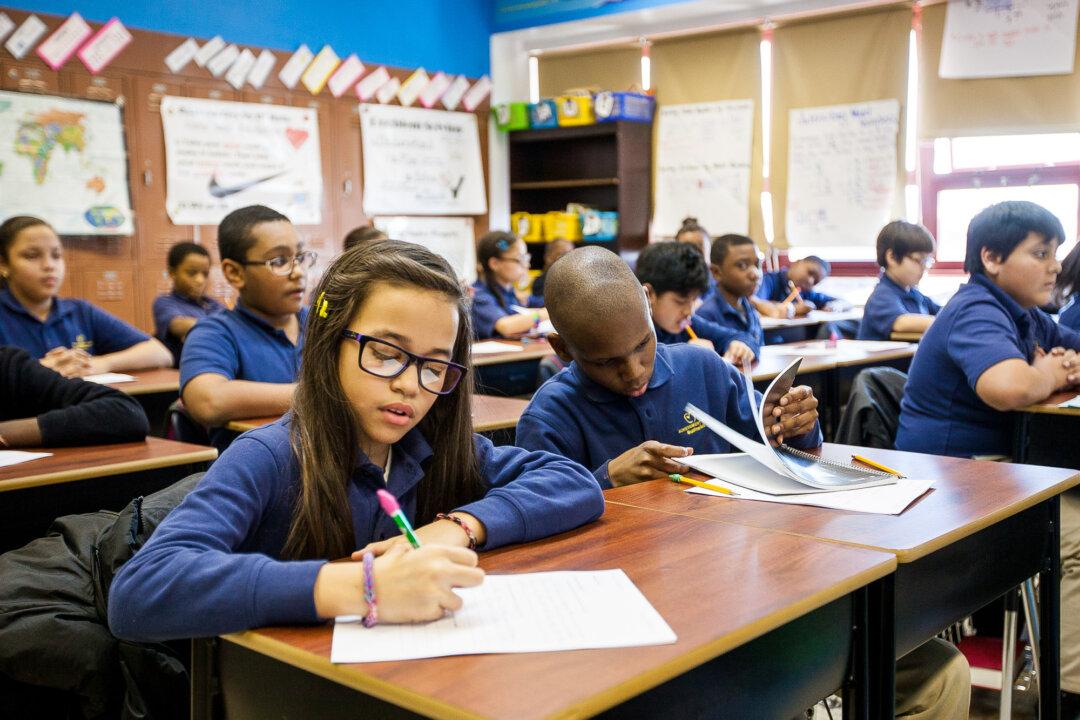NEW YORK—Requel Russell-George is a mother of two students at Public School 169 in the Bronx. She said she feels the school is excellent, but she would like to see more diversity.
“I do feel that it would be great for our children and other children to be exposed to other cultures,” Russell-George said. “You’re more knowledgeable and things are not mysterious to you as you get older.” The school has about 75 percent black and 19 percent Latino students.
“New York’s record on school segregation by race and poverty is dismal now and has been for a very long time,” states a recent report by the Civil Rights Project at the University of California at Los Angeles.
The number of black and Latino students in highly segregated New York City public schools rose steadily over the last two decades. By 2011, close to 85 percent of black and 75 percent of Latinos were in schools with less than 10 percent of white students.
Racial segregation is a problem, mainly because many of these schools have high concentrations of low-income students, the report authors argue.
A typical white student in the city attended a school where less than 55 percent of the classmates were low-income. Meanwhile, the typical black or Latino student attended a school where close to 80 percent of the classmates were low-income, according to 2011 data. Overall, 74 percent of the city’s students are considered low income.
Concentration of poverty then leads to a substantial increase of lower grades, lack of quality teachers, lack of quality curricula, and materials.
On the other hand, diverse schools provide better cultural awareness and, statistically, even better academic results.
“Studies have shown that desegregated settings are associated with heightened academic achievement for minority students, with no corresponding detrimental impact for white students,” the report states.
New York City Department of Education spokesman Devon Puglia did not address the findings of the report, but said, “We believe in diverse classrooms in which students interact and grow through personal relationships with those of different backgrounds.” The city schools are roughly 40 percent Hispanic, 30 percent black, 15 percent white, and 15 percent Asian.
State Education Commissioner John King called the findings troubling and added, “The department has supported over the years various initiatives aimed at improving school integration and school socioeconomic integration, but there’s clearly a lot of work that needs to be done—not just in New York, but around the country.”
The study suggests that New York’s segregation is largely due to housing patterns, because housing and school segregation go hand in hand, but that it could be mitigated through policies intended to promote diversity.
Charters Super-Segregated, Not So Poor
“Charter schools take the metro’s segregation to an extreme,” the report states. Having less than 1 percent of white enrollment, 73 percent of city’s charter schools are considered “apartheid schools.”
Authors of the report argue many charters are focused exclusively on high-poverty neighborhoods, and even if they set up in more affluent areas, their schools “sometimes with strict codes of conduct ... typically have little appeal for middle-class parents.”
Charter school students in the city have close to the same low-income rates as in traditional district schools, 76 to 74 percent. Yet there are very few with a high poverty concentration. While over 40 percent of schools in the Bronx have low-income rates over 90 percent, only 12 percent of charter schools in the borough do. In other boroughs the differences are similarly significant.
Yet, charter students are 92 percent black or Latino, compared to 70 percent citywide. That would suggest charter schools may not be popular among middle-class white and Asian parents, but are sought after by middle-class black and Latino parents.
History of Segregation
The report analyzes the city’s demographics as early as the 17th century. Due to slavery, the city was 40 percent black by 1660, so outlawing slavery in 1827 created one of the largest free, black communities in the north.
But due to an influx of white immigrants and racial conflicts getting violent, by 1870 the black population dropped to 1.4 percent. The communities of color started to build up again with the start of the 20th century, especially black and Puerto Rican. Mass immigration from Asia started mainly after passing of the Immigration Act of 1965.
Now New York City is 50 percent black and Latino and 12 percent Asian. But despite the fact that it is the “most heterogeneous and highly populated area in the country ... many neighborhoods across the area have seen little diversity for years,” the report states.
During the 1980s, diversity initiatives were launched, including magnet schools, with curriculum focused on a particular topic, be it art or technology. Magnet schools notably improved diversity, but with more white people fleeing to the suburbs, the effect diminished.
As the numbers of minorities kept increasing, the last two decades of administrations abandoned most of the diversity efforts, according to the report.
The report recommends a series of policy changes, such as building affordable housing near high quality schools, offering transportation to students who would be willing to participate in voluntary integration, and promoting benefits of diversified school communities and the downfalls of segregation.
The Associated Press contributed to this report.





